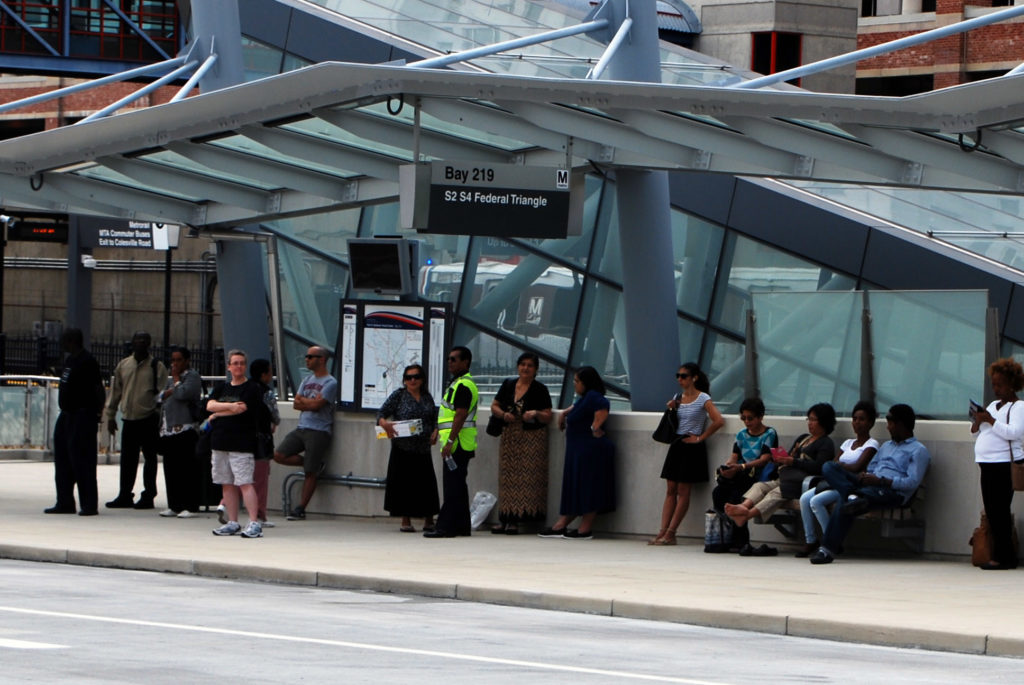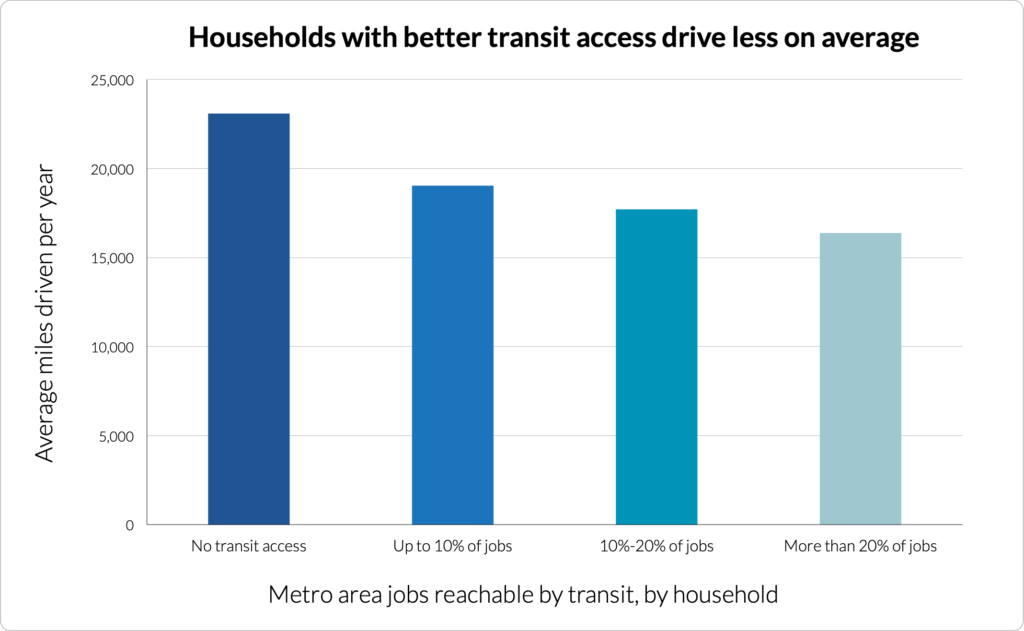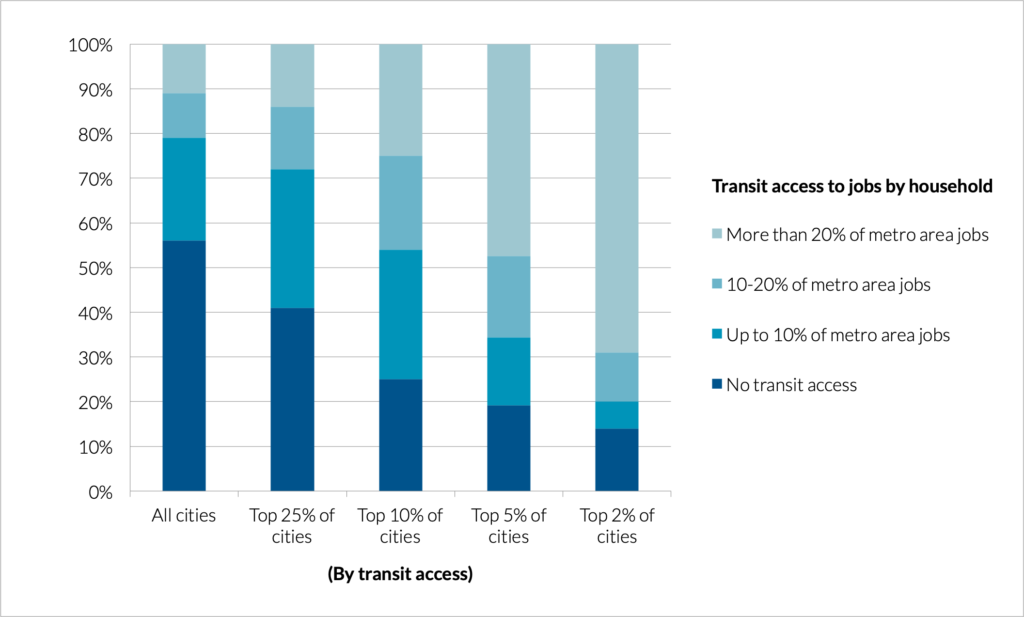Reducing emissions with better transit, part two: Improve transit access
Increasing funding for transit operations is a vital first step to help more people drive less, but there’s an equally important next step: connecting more people by transit to more of the destinations they currently reach by car.

This post was written by Rayla Bellis, Director of Thriving Communities at Smart Growth America, and Abi Grimminger, T4America Communications Associate. This is the second of a series of posts on this topic—find the full set here.
In our first installment of this series on the importance of transit to reduce emissions, we focused on increasing spending on transit operations—more buses, more trains, running more often (in the 288 urbanized areas with available data.) We found that by increasing federal support for transit operations across these areas, we can make meaningful progress in reducing driving emissions. But while that’s a crucial step in the right direction to meet our climate goals, we also need to consider how to expand access to transit and help more people use transit to get where they need to go.
Pairing expanded transit service with greater access to transit
For a second phase of our analysis of how investing in transit can help meet our climate goals, we looked at what we could achieve by improving transit access—in this case meaning how well transit connects people from their homes to available jobs in their region within a reasonable travel time. Improving transit access goes beyond simply expanding transit service. While offering more routes or more frequent service can certainly improve transit access, it won’t necessarily do so if those routes aren’t designed to connect the places where people live as directly as possible to the places they need to go
In the 288 urbanized areas studied, we examined the annual vehicle miles traveled (VMT) estimates for all 88.5 million households included in the 2017 National Household Travel Survey. We analyzed what share of their regions’ jobs (within 45 minutes from their homes) they could reach with existing transit service using data from the EPA’s Smart Location Database. Unsurprisingly the households that are unable to reach any jobs by transit within that time frame traveled quite a bit by car—averaging 23,090 miles per year.
Households that could get to work using transit drove significantly less, and the improvement came with even modest levels of access to jobs via public transportation. Households that could reach just 10 percent of jobs in their metropolitan area by transit drove 19,040 miles per year (an 18 percent drop). When that access increased modestly up to 10-20 percent of jobs, households drove 17,710 miles per year on average (a 23 percent drop), and when they could reach over 20 percent of all metro-area jobs with transit, average driving in those households dropped to 16,380 miles (or 29 percent less than households with no transit access).

Even improving transit access to connect people to up to 20 percent of metropolitan area (MSA) jobs leads to significant drops in average miles driven per year, reducing emissions.
Based on those results, we estimate that if we could manage to give all 88.5 million households we studied access to at least 20 percent of their region’s jobs by transit by 2050, we could reduce annual vehicle miles traveled by these households by 23 percent, leading to a total reduction in VMT (including non-household trips like deliveries and ridesharing) in those urbanized areas of 16 percent in 2050 compared to projected VMT based on our current trend. This is 377 billion fewer miles driven annually. Given that transportation emissions are the main perpetrators of greenhouse gas emissions in the U.S., this would be a major step toward improving climate outcomes.
Raising the bar
Providing all households in the 288 urbanized areas we studied with access to at least 20 percent of their region’s jobs by 2050 will require more than simply increasing investment in transit or even just running more trains and buses because of the existing low-density suburban development in many of these regions, which has contributed heavily to VMT growth and emissions in these cities. It will take a real push to make transit-supportive land-use decisions and provide the right transit service to connect people to the destinations they need. But that doesn’t mean it can’t be done. In fact, some urbanized areas are already providing a significant share of their residents with access to at least 20 percent of their regions’ jobs by transit today, raising the bar for communities across the country.
In cities like Champaign, IL, Bloomington, IL, Duluth, MN-WI, and Boulder, CO, more than 70 percent of households can currently reach more than 20 percent of metropolitan-area jobs using transit. Bringing all 288 urbanized areas we studied up to a level of access comparable to those regions by 2050 (in line with the current top 2 percent of cities in the graphic below) would result in an 11.9 percent reduction in VMT in 2050, compared to what is currently projected for that year. Though a slightly less ambitious target, bringing all 288 urbanized areas up to the level of access provided in the top 5 percent of cities would still have a sizable impact, resulting in a 9.5 percent reduction. That would significantly reduce both emissions and the amount of time Americans spend in their cars on average—a win for the environment and for commuters.

In cities with the best current transit access (those in the top 2 percent), about 70 percent of households can reach more than 20 percent of their jobs by transit.
Bringing all 288 urbanized areas to the level of access provided by the current top-performing regions could reduce annual VMT in 2050 by 11.9 percent compared to currently projected levels for that year.
| If we brought all 288 urbanized areas up to a minimum level of transit access to jobs already achieved by the… | …we could achieve a reduction in annual VMT in 2050 of… | …meaning a cumulative VMT reduction over 30 years of… |
|---|---|---|
| Top 25% of urbanized areas | -3.7% | -2.0% |
| Top 10% of urbanized areas | -6.5% | -3.6% |
| Top 5% of urbanized areas | -9.5% | -5.2% |
| Top 2% of urbanized areas | -11.9% | -6.5% |
Source: Estimated using data on household VMT from the 2017 National Household Travel Survey and data on transit accessibility from the EPA Smart Location Database.
It is important to note that the impacts of poor access to transit aren’t felt equally. People who most need an affordable alternative to car travel are often the same people who don’t have viable transit access. Black workers are four times more likely to take transit than white workers, yet transit access is roughly 24 percent worse in the quartile of urban areas with the most Black residents, compared with those with the fewest. Areas with high poverty rates get less frequent, reliable transit service than wealthy neighborhoods. If we want to face climate goals head-on, we also have to address these inequities in transit access.
But how?
Increasing access to jobs via transit will require an intentional policy and investment strategy, because it depends on several factors beyond just how much we spend on transit: how well transit serves different populations currently, development patterns in the region, and where jobs and services are clustered. And overall, to make the more ambitious scenarios possible, changes in local and metro-area land-use decisions need to go hand-in-hand with the increased transit investment.
Some cities would need to spend a great deal to significantly improve transit access in the more sprawling portions of their regions if development practices don’t change, which is all the more reason to change those development practices now. Yet scores of cities could likely make meaningful improvements to transit access with very little additional spending. For instance, some cities (like Columbus, OH and Houston, TX) have been able to expand transit access simply by reconsidering the way their routes are structured and reconfiguring their service from the ground up with a focus on improving access.
To address the pressing need to reduce emissions from transportation to meet ambitious climate goals, we’ll need to not only invest more money overall in running more buses and trains more often, but also consider how to expand that transit service into more places and serve more people—especially those who need it most. More on this in an accompanying report coming in the new year.




















1 Comment